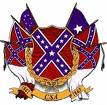From The Arkansas Toothpick:
 Major General Earl Van Dorn arrived at Little Rock on the evening of January 28, and took a room at the luxurious Anthony House, the Capital city’s leading hotel. He was assigned by the Secretary of War to command the Trans-Mississippi District on January 10th, as previously stated.
Major General Earl Van Dorn arrived at Little Rock on the evening of January 28, and took a room at the luxurious Anthony House, the Capital city’s leading hotel. He was assigned by the Secretary of War to command the Trans-Mississippi District on January 10th, as previously stated.
One Hundred and Fifty Years Ago: Van Dorn Takes Command; Railroad Work Peaks
The next day he issued his first general order by which he formally assumed the command. He then ordered all officers and men on furlough to return to their regiments. Immediately afterward he called upon Governor Rector for ten more companies of infantry and four artillery companies from Arkansas. In doing so, he inadvertently got the wholehearted co-operation of the governor by explaining the new troops would guard the state from invasion and assist in driving the enemy from MO. The governor like many others was displeased at the removal of Arkansas troops to Kentucky in ’61. But it proved to be a promise Van Dorn couldn’t keep. In three months he unforeseeably had to take them east of the Mississippi.
Among Van Dorn’s appointed staff officers were two Virginians, West Pointer’s with over 15 years service in the old army. Major William L Cabell was Chief of the Quartermaster Department. During the previous summer he served in that capacity for Gen Beauregard during the battle of Bull Run. He would later rise to prominence in Arkansas as a hell-for-leather cavalry general. Colonel Dabney H Maury graduated from the University of Virginia in 1842, studied law, but entered West Point (USMA) rather than establish a legal practice. When he resigned his commission in 1861, this Mexican War veteran and esteemed Military Academy instructor entered Confederate service as a captain of cavalry, but in early 1862 was promoted and assigned as Chief of Staff to Gen Van Dorn. Kentucky native and former cavalry captain William N R Beall was appointed to the USMA from Chicot County Arkansas in 1844. As with so many of the young officers of his day, his service was primarily on the frontier skirmishing with Indians or attending to Kansans border disturbances. He impressed Van Dorn as a man born to military life. The general would twice recommend Beal for a colonelcy. Instead Congress confirmed him as a Brigadier General on April 11, 1862.
The three men were aggressive to a mature level and provided an excellent nucleus to assist an army commander. It was probable President Davis was instrumental in furnishing these three professionals, but his friend Gen Van Dorn would demonstrate a need for a dynamic staff to stabilize his battlefield performance.
January 26, 1862 was a special day for Central Arkansas because the western section of the Memphis and Little Rock railroad was completed. Its terminal point was on the north side of the Arkansas River at Huntersville Station.
A brief ceremony took place 11 miles from that site with the honor of driving the last spike given to Mr. William E Woodruff of Little Rock, one of the directors of the railroad company and the oldest representative of the press in Arkansas, having founded the Arkansas Gazette in 1819. Then followed a short speech by Christopher C Danley, current editor of the newspaper who envisioned a larger circulation implemented through this mode of transportation. Soon the mail from Memphis would arrive seven hours earlier then usual. With trains leaving Huntersville every morning at eight o’clock, traveling time to Memphis would soon be reduced to 24 hours as opposed to normal 36 hours, which was surely encouraging to Mr. Danley.
Nine years had passed since the railroad had been chartered, yet there still remained a gap of 45 miles in the road between the White and St Francis Rivers. Even so the railroad was of great benefit, because it connected Little Rock and its environs with the White River at DeValls Bluff which unlike the Arkansas stayed navigable at all seasons.


No comments:
Post a Comment
Note: Only a member of this blog may post a comment.